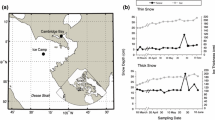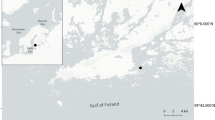Abstract
Metabolic activity of bacteria was investigated in open water, newly forming sea ice, and successive stages of pack ice in the Weddell Sea. Microautoradiography, using [3H]leucine as substrate, was compared with incorporation rates of [3H]leucine into proteins. Relation of [3H]leucine incorporation to the biomass of active bacteria provides information about changes of specific metabolic activity of cells. During a phytoplankton bloom in an ice-free, stratified water column, total numbers of bacteria in the euphotic zone averaged 2.3 × 105 ml−1, but only about 13% showed activity via leucine uptake. Growth rate of the active bacteria was estimated as 0.3–0.4 days−1. Total cell concentration of bacteria in 400 m depth was 6.6 × 104 ml−1. Nearly 50% of these cells were active, although biomass production and specific growth rate were only about one-tenth that of the surface populations. When sea ice was forming in high concentrations of phytoplankton, bacterial biomass in the newly formed ice was 49.1 ng C ml−1, exceeding that in open water by about one order of magnitude. Attachment of large bacteria to algal cells seems to cause their enrichment in the new ice, since specific bacterial activity was reduced during ice formation, and enrichment of bacteria was not observed when ice formed at low algal concentration. During growth of pack ice, biomass of bacteria increased within the brine channel system. Specific activity was still reduced at these later stages of ice development, and percentages of active cells were as low as 3–5%. In old, thick pack ice, bacterial activity was high and about 30% of cells were active. However, biomass-specific activity of bacteria remained significantly lower than that in open water. It is concluded that bacterial assemblages different to those of open water developed within the ice and were dominated by bacteria with lower average metabolic activity than those of ice-free water.
Similar content being viewed by others
References
Atlas RM (1986) Applicability of general ecological principles to microbial ecology. In: Poindexter JS, Leadbetter ER (eds) Methods and special applications in bacterial ecology. (Bacteria in nature, vol. 2) Plenum Press, New York, pp 339–370
Bathmann U, Grossmann S, Lochte K, Scharek R, Schröder M (1992) The Coastal Current between the stations Georg-von-Neumayer and Georg-Forster. In: Bathmann U, Schulz-Baldes M, Fahrbach E, Smetacek V, Hubberten HW (eds) The expeditions ANTARKTIS IX/1–4 of the Research Vessel “Polarstern” in 1990/91. Rep Polar Res 100:175–179
Bjørnsen PK, Kuparinen J (1991) Determination of bacterioplankton biomass, net production and growth efficiency in the Southern Ocean. Mar Ecol Prog Ser 71:185–194
Børsheim KY, Bratbak G, Heldal M (1990) Enumeration and biomass estimation of planktonic bacteria and viruses by transmission electron microscopy. Appl Environ Microbiol 56:352–356
Cota GF, Kottmeier ST, Robinson DH, Smith Jr WO, Sullivan CW (1990) Bacterioplankton in the marginal ice zone of the Weddell Sea: biomass, production, and metabolic activities during austral autumn. Deep-Sea Res 37:1145–1167
Daley RJ, Hobbie JE, (1975) Direct counts of aquatic bacteria by a modified epifluorescence technique. Limnol Oceanogr 20:875–882
Delille D (1992) Marine bacterioplankton at the Weddell Sea ice edge, distribution of psychrophilic and psychrotrophic populations. Polar Biol 12:205–210
Douglas DJ, Novitsky JA, Fournier RO (1987) Microautoradiography-based enumeration of bacteria with estimates of thymidine-specific growth and production rates. Mar Ecol Prog Ser 36:91–99
Eicken H (1992) The role of sea ice in structuring Antarctic ecosystems. Polar Biol 12:3–13
El-Sayed SZ, Fryxell GA (1993) Phytoplankton. In: Friedmann El (ed) Antarctic microbiology. Wiley-Liss, Inc., New York, pp 65–122
Evans CA, O'Reilly JE, Thomas JP (1987) A handbook for the measurement of chlorophyll a and primary production. (Biological investigations of marine Antarctic systems and stocks (BIOMASS), vol. 8) Texas A&M University, College Station, Texas
Flynn KJ, Butler I (1986) Nitrogen sources for the growth of marine microalgae: role of dissolved free amino acids. Mar Ecol Prog Ser 43:281–304
Fuhrman JA, Azam F (1982) Thymidine incorporation as a measure of heterotrophic bacterioplankton production in marine surface waters: evaluation and field results. Mar Biol 66:109–120
Garrison DL, Buck KR (1989) The biota of Antarctic pack ice in the Weddell Sea and Antarctic Peninsula regions. Polar Biol 10:211–219
Garrison DL, Ackley SF, Buck KR (1983) A physical mechanism for establishing algal populations in frazil ice. Nature 306:363–365
Garrison DL, Close AR, Reimnitz E (1989) Algae concentrated by frazil ice: evidence from laboratory experiments and field measurements. Antarct Sci 1:313–316
Gehrtsen C, Kneser HO, Vogel H (1986) Physik, 15th edn. Springer-Verlag, Berlin
Gleitz M, Thomas DN (1993) Variation in phytoplankton standing stock, chemical composition, and physiology during sea-ice formation in the southeastern Weddell Sea, Antarctica. J Exp Mar Biol Ecol 173:211–230
Grossmann S (1993) Microbiology of sea ice. In: Spindler M, Dieckmann G, Thomas D (eds) The expedition ANTARKTIS X/3 of RV “Polarstern” in 1992. Rep Polar Res 121:15–18
Grossmann S, Reichardt W (1991) Impact of Arenicola marina on bacteria in intertidal sediments. Mar Ecol Prog Ser 77:85–93
Grossmann S, Lochte K (1992) Microbiology of sea ice. In: Bathmann U, Schulz-Baldes M, Fahrbach E, Smetacek V, Hubberten H-W (eds) The expeditions ANTARKTIS IX/1-4 of the Research Vessel “Polarstern” in 1990/91. Rep Polar Res 100:151–153
Grossmann S, Gleitz M (1993) Microbial responses to experimental sea-ice formation: implications for the establishment of Antarctic sea-ice communities. J Exp Mar Biol Ecol 173:273–289
Hobbie JE, Daley RJ, Jasper S (1977) Use of Nuclepore filters for counting bacteria by fluorescence microscopy. Appl Environ Microbiol 33:1225–1228
Hoppe H-G (1976) Determination and properties of actively metabolizing heterotrophic bacteria in the sea, investigated by means of micro-autoradiography. Mar Biol 36:291–302
Hoppe H-G (1978) Relations between active bacteria and heterotrophic potential in the sea. Neth J Sea Res 12:78–98
Horner RA, Alexander V (1972) Algal populations in Arctic sea ice: an investigation of heterotrophy. Limnol Oceanogr 17:454–458
Horner R, Ackley SF, Dieckmann GS, Gulliksen B, Hoshiai T, Legendre L, Meinikov IA, Reeburgh WS, Spindler M, Sullivan CW (1992) Ecology of sea ice biota. 1. Habitat, terminology, and methodology. Polar Biol 12:417–427
Karl DM (1993) Microbial processes in the southern oceans. In: Friedmann El (ed) Antarctic microbiology. Wiley-Liss, Inc., New York, pp 1–63
Kirchman D, Sigda J, Kapuscinski R, Mitchell R (1982) Statistical analysis of the direct count method for enumerating bacteria. Appl Environ Microbiol 44:376–382
Kirchman D, K'Nees E, Hodson R (1985) Leucine incorporation and its potential as a measure of protein synthesis by bacteria in natural aquatic systems. Appl Environ Microbiol 49:599–607
Kirchman DL, Newell SY, Hodson RE (1986) Incorporation versus biosynthesis of leucine: implications for measuring rates of protein sythesis and biomass production by bacteria in marine systems. Mar Ecol Prog Ser 32:47–59
Kottmeier ST, Sullivan CW (1988) Sea ice microbial communities (SIMCO). 9. Effects of temperature and salinity on rates of metabolism and growth of autotrophs and heterotrophs. Polar Biol 8:293–304
Kottmeier ST, Sullivan CW (1990) Bacterial biomass and production in pack ice of Antarctic marginal ice edge zones. Deep-Sea Res 37:1311–1330
Lange MA, Ackley SF, Wadhams P, Dieckmann GS, Eicken H (1989) Development of sea ice in the Weddell Sea. Ann Glaciol 12:92–96
Marra J, Burckle LH, Ducklow HW (1982) Sea ice and water column plankton distributions in the Weddell Sea in late winter. Antarct J U S 17:111–112
Meyer-Rell L-A (1978) Autoradiography and epifluorescence microscopy combined for the determination of number and spectrum of actively metabolizing bacteria in natural waters. Appl Environ Microbiol 36:506–512
Morita RY (1975) Psychrophilic bacteria. Bacteriol Rev 39:144–167
Palmisano AC, Garrison DL (1993) Microorganisms in Antarctic sea ice. In: Friedmann El (ed) Antarctic microbiology. Wiley-Liss, Inc., New York, pp 167–218
Pedrós-Alió C, Newell SY (1989) Microautoradiographic study of thymidine uptake in brackish waters around Sapelo Island, Georgia, USA. Mar Ecol Prog Ser 55:83–94
Pomeroy LR, Wiebe WJ, Deibel D, Thompson RJ, Rowe GT, Pakulski JD (1991) Bacterial responses to temperature and substrate concentration during the Newfoundland spring bloom. Mar Ecol Prog Ser 75:143–159
Putt M, Børsheim KY, Miceli G, Stoecker DK (1990) Seasonal changes in cell size and abundance of bacterioplankton during the Phaeocystis sp. bloom in McMurdo Sound. Antarct J U S 25:199–201
Rogers AW (1979) Techniques of autoradiography, 3rd edn. Elsevier/North-Holland Biomedical Press, Amsterdam
Simon M (1991) Isotope dilution of intracellular amino acids as a tracer of carbon and nitrogen sources of marine planktonic bacteria. Mar Ecol Prog Ser 74:295–301
Sokal RR, Rohlf FJ (1981) Biometry, 2nd edn. Freeman and Co., San Francisco
Sullivan CW, Palmisano AC (1984) Sea ice microbial communities: distribution, abundance, and diversity of ice bacteria in McMurdo Sound, Antarctica, in 1980. Appl Environ Microbiol 47:788–795
Sullivan CW, Palmisano AC, Kottmeier S, Grossi SM, Moe R (1985) The influence of light on growth and development of the sea-ice microbial community of McMurdo Sound. In: Siegfried WR, Condy PR, Laws RM (eds) Antarctic nutrient cycles and food webs. Springer-Verlag, Berlin, pp. 78–83
Tabor PS, Neihof RA (1982) Improved microautoradiographic method to determine individual microorganisms active in substrate uptake in natural waters. Appl Environ Microbiol 44:945–953
Thingstad TF, Martinussen I (1991) Are bacteria active in the cold pelagic ecosystem of the Barents Sea? Polar Res 10:255–266
van Wambeke F, Bianchi MA (1990) Effect of organic nitrogen enrichments on marine planktonic networks and heterotrophic bacterial potential. Mar Ecol Prog Ser 63:17–25
Weeks WF, Ackley SF (1982) The growth, structure and properties of sea ice. CRREL Monograph 82–1, Cold Reg. Res. Eng. Lab., Hanover, New Hampshire
Weissenberger J (1992) Die Lebensbedingungen in den Solekanälchen des antarktischen Meereises (in German with English abstract). Rep Polar Res 111:1–159
Wiebe WJ, Sheldon Jr WM, Pomeroy LR (1992) Bacterial growth in the cold: evidence for enhanced substrate requirement. Appl Environ Microbiol 58 359–364
Zdanowski MK, Donachie SP (1993) Bacteria in the sea-ice zone between Elephant island and the South Orkneys during the Polish sea-ice zone expedition (December 1988 to January 1989). Polar Biol 13:245–254
Author information
Authors and Affiliations
Rights and permissions
About this article
Cite this article
Grossmann, S. Bacterial activity in sea ice and open water of the Weddell Sea, Antarctica: A microautoradiographic study. Microb Ecol 28, 1–18 (1994). https://doi.org/10.1007/BF00170244
Received:
Revised:
Issue Date:
DOI: https://doi.org/10.1007/BF00170244




